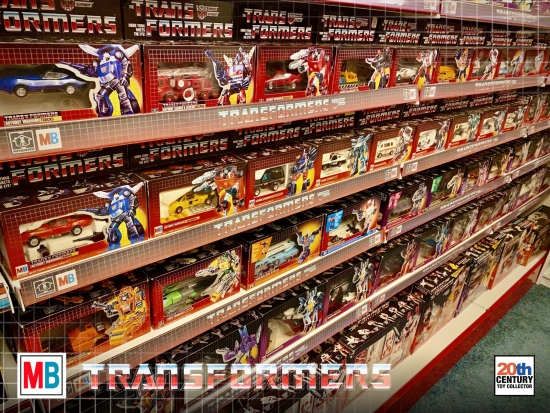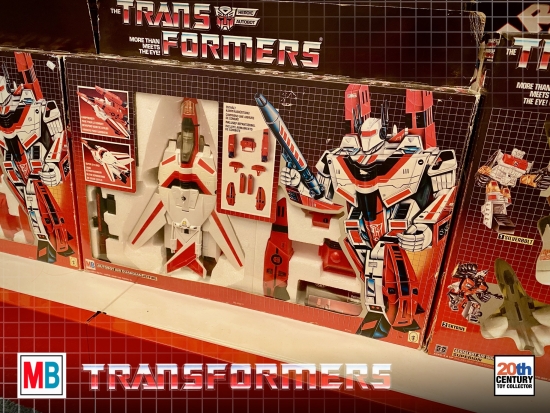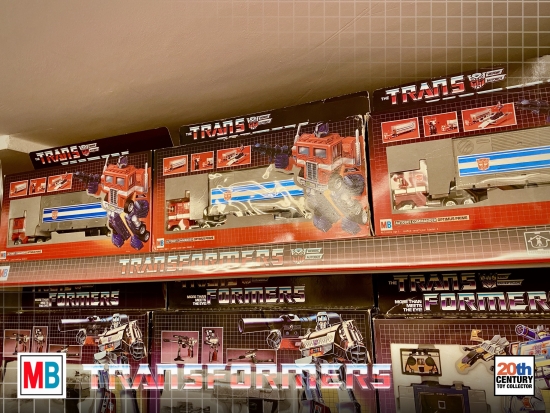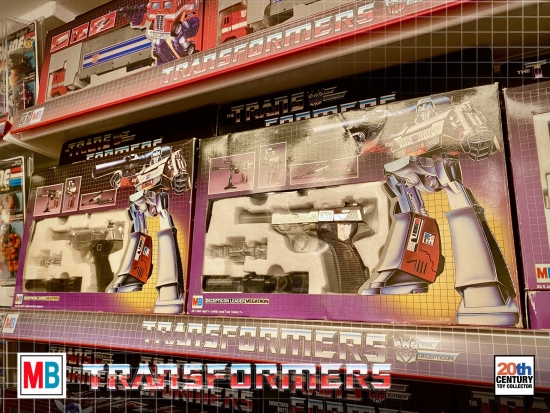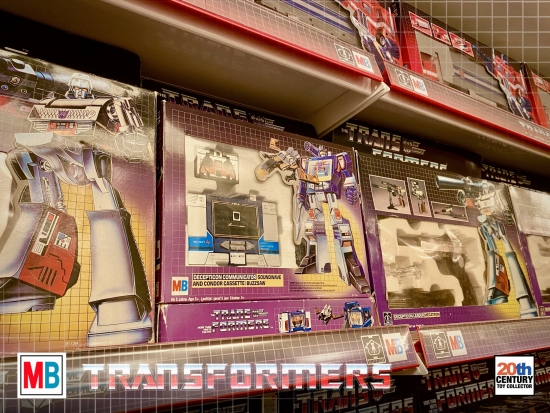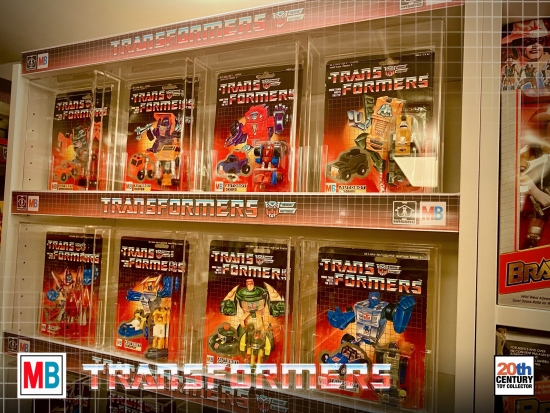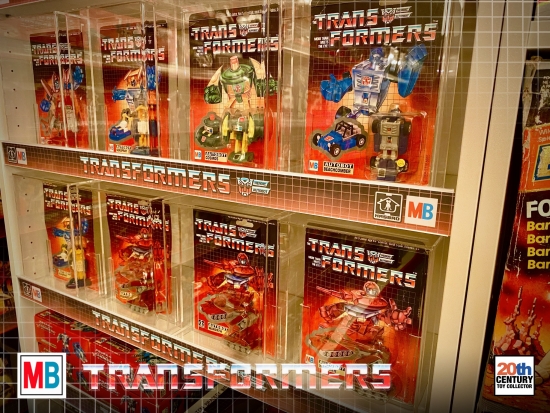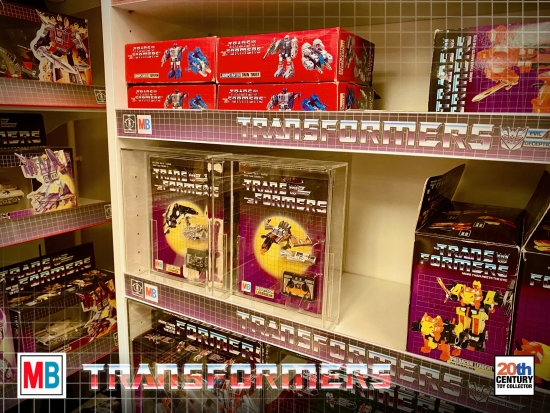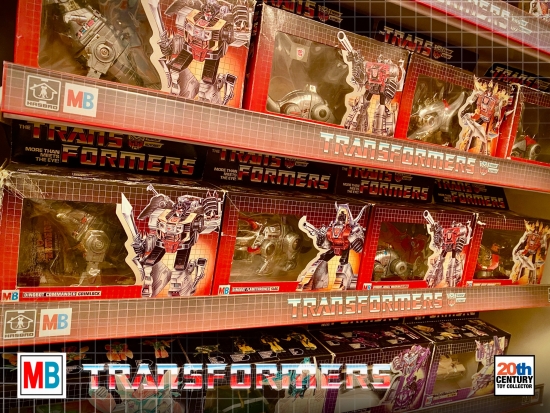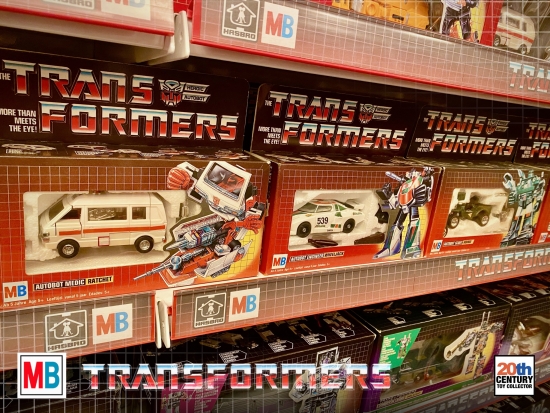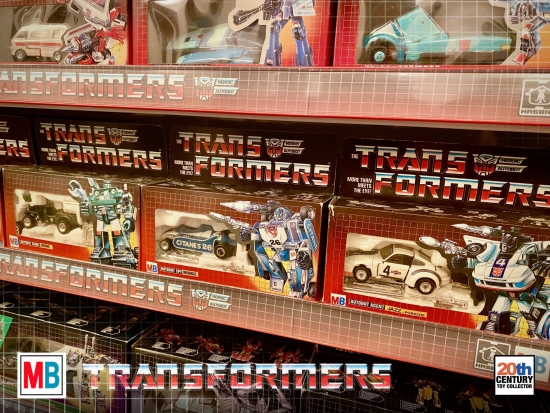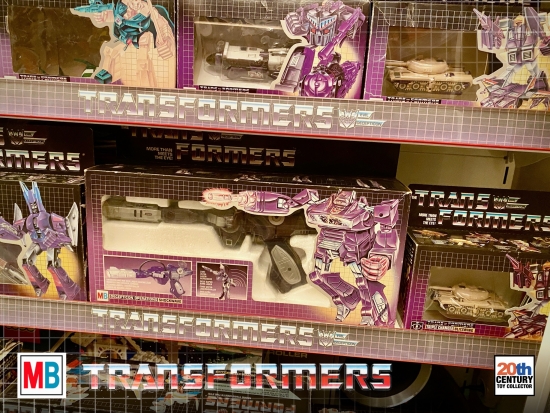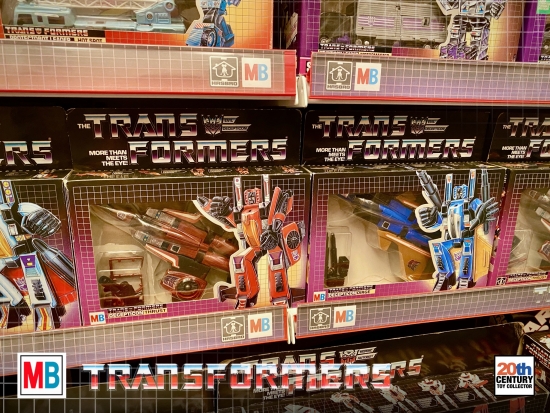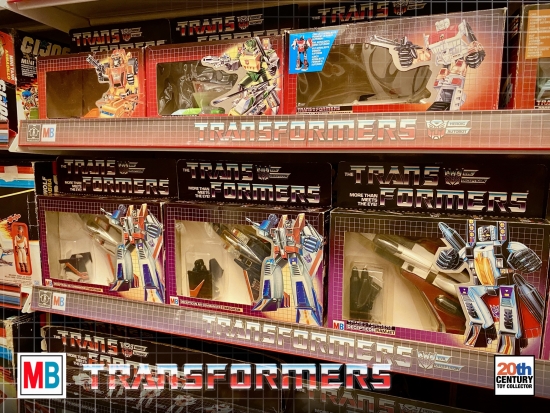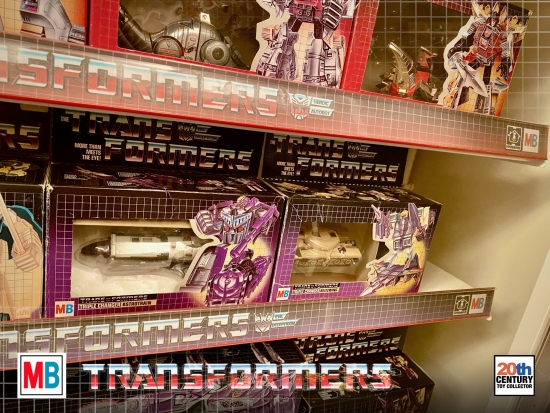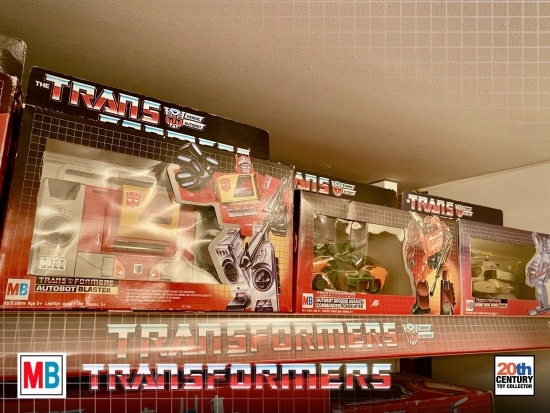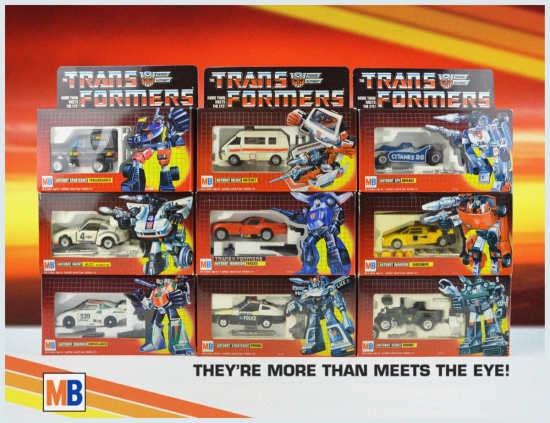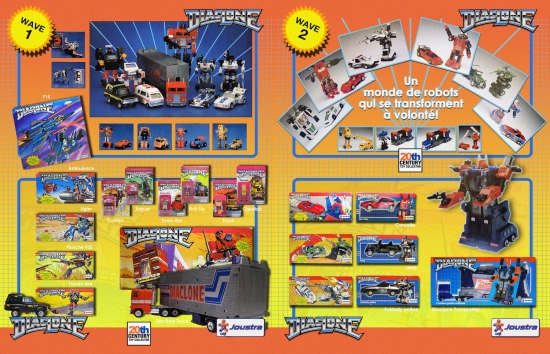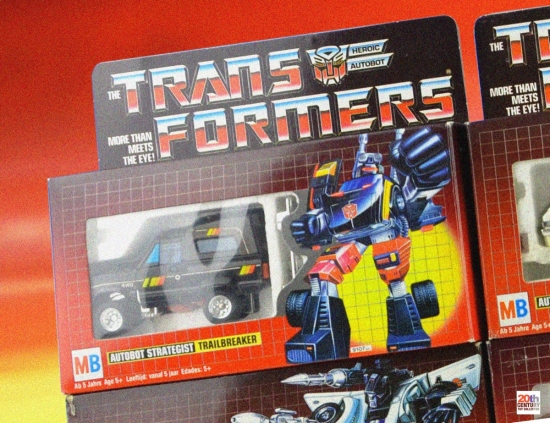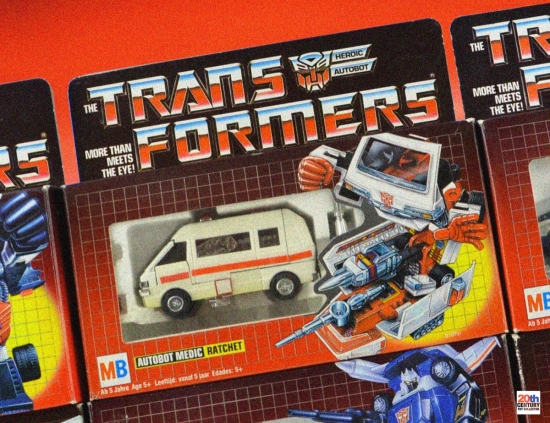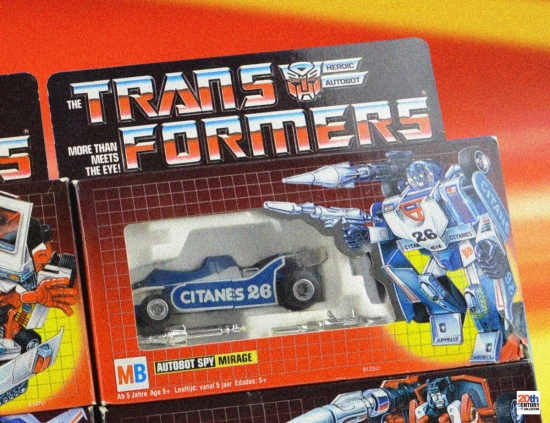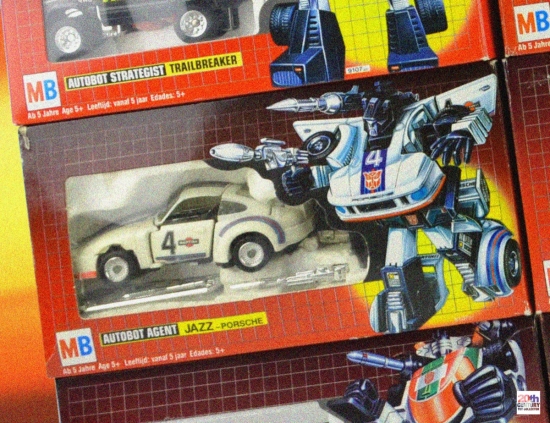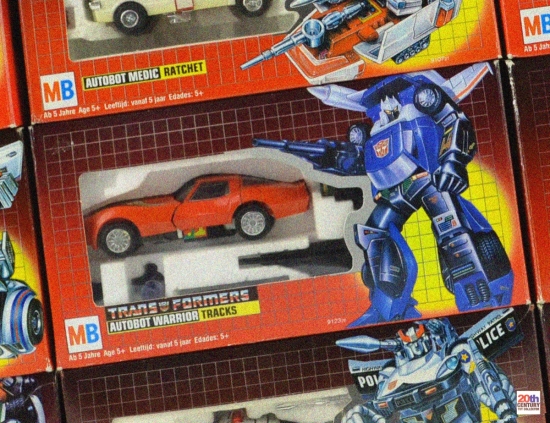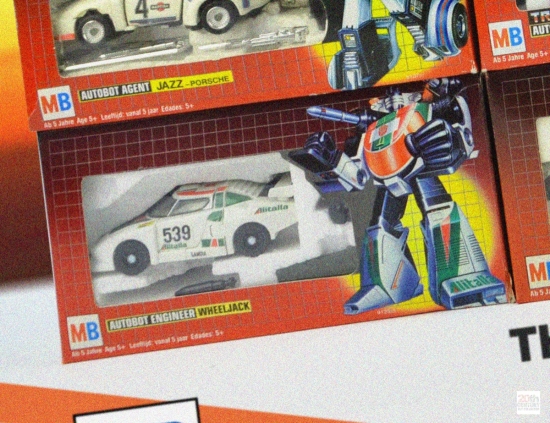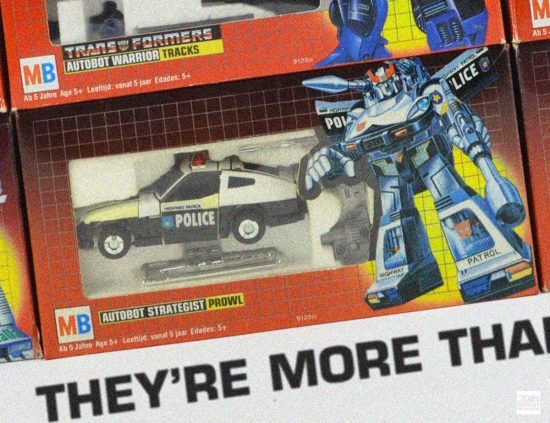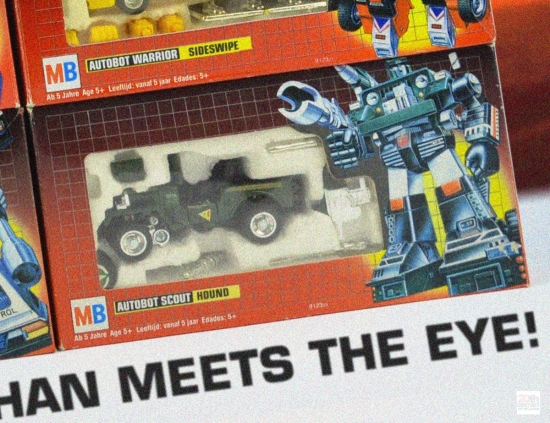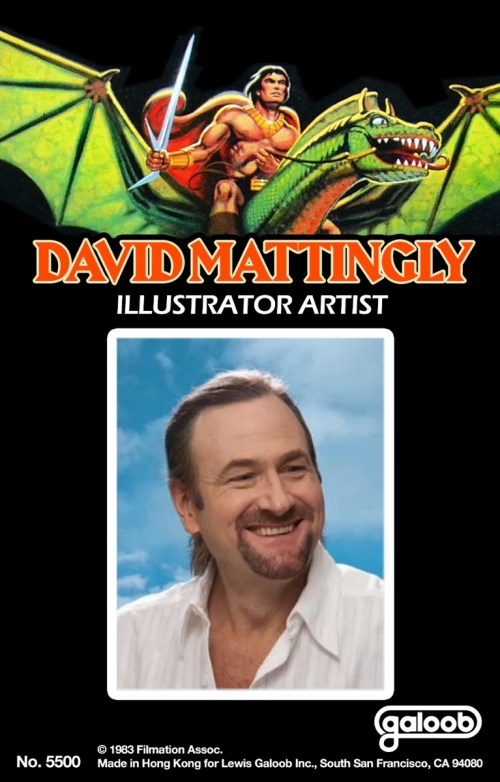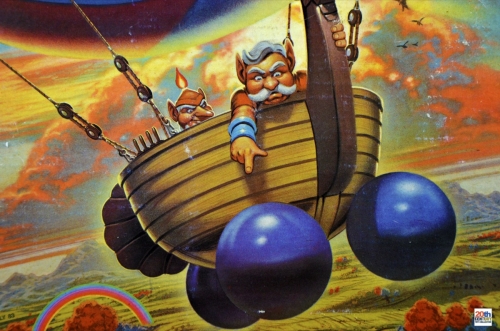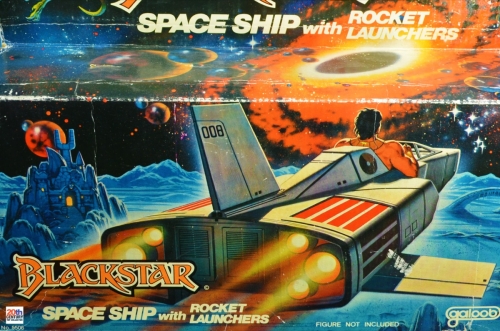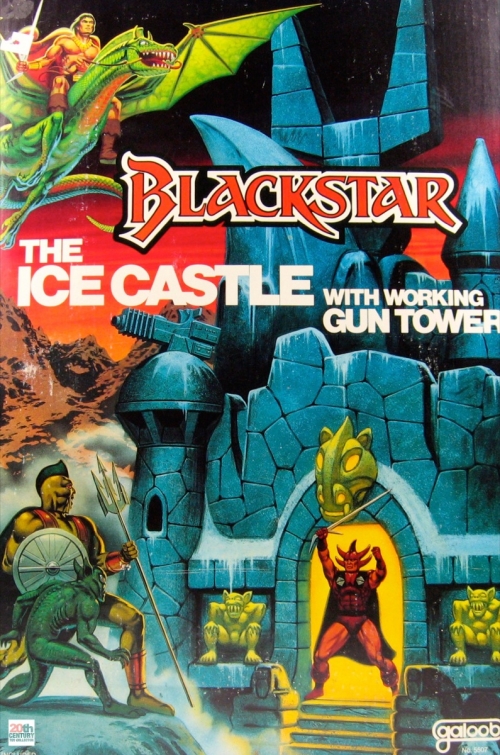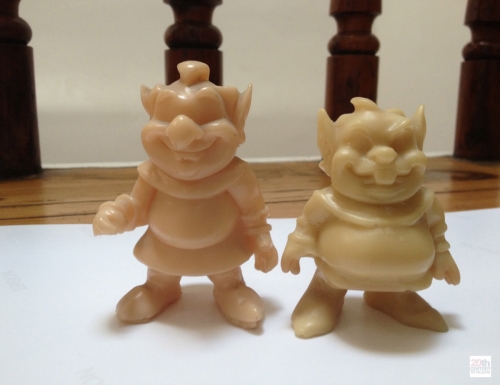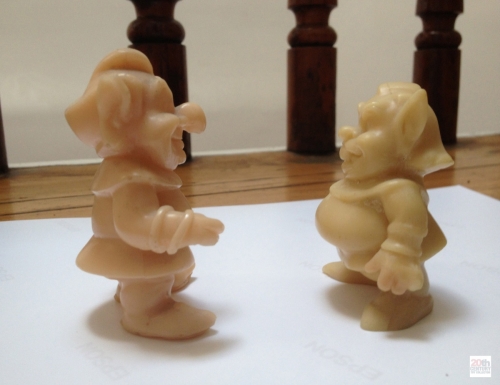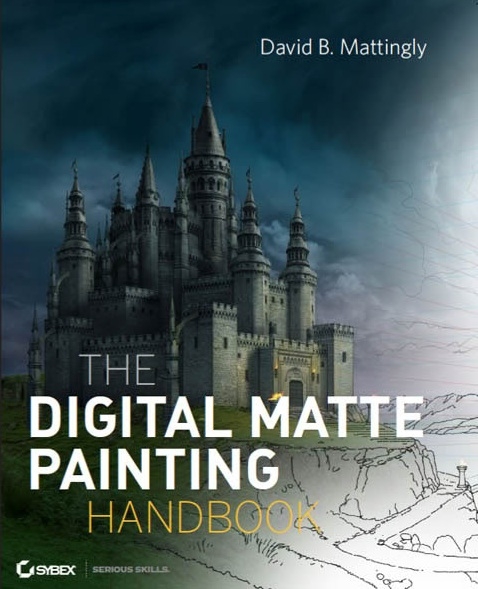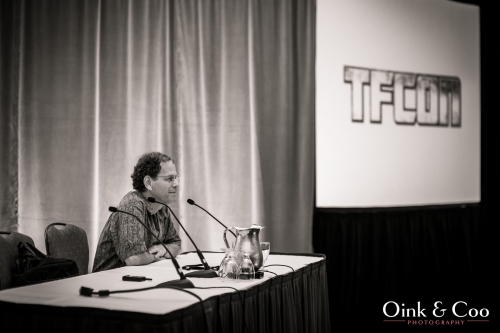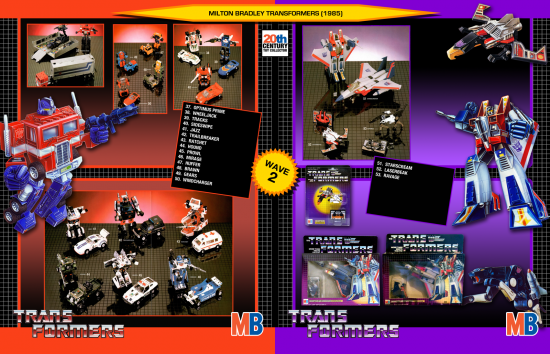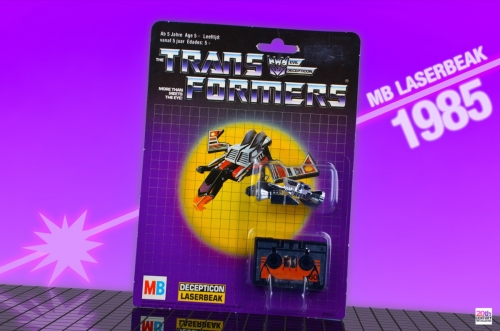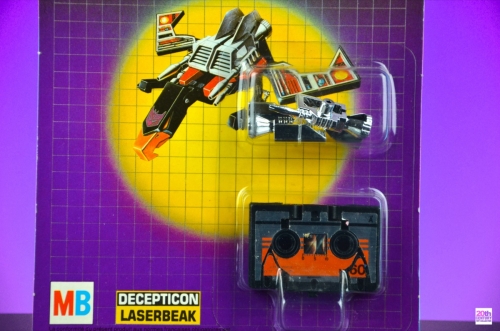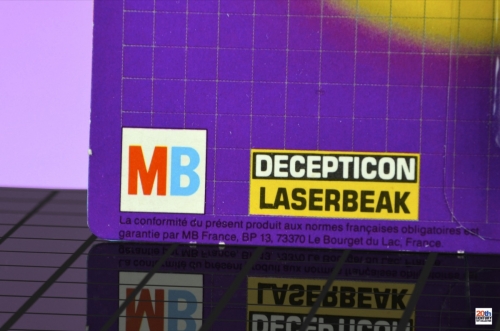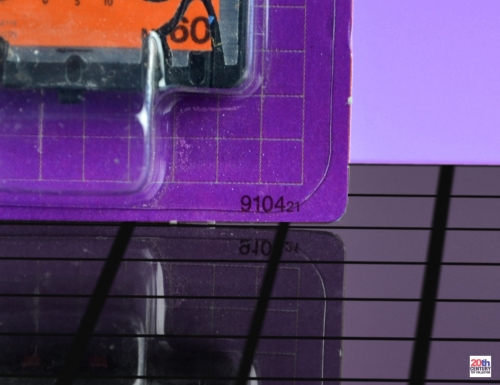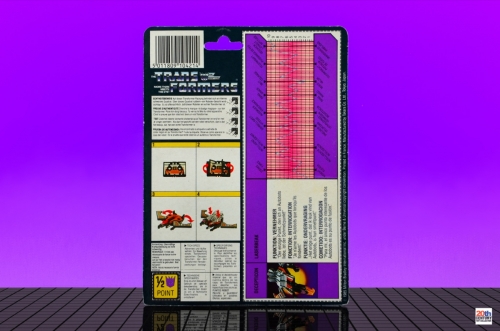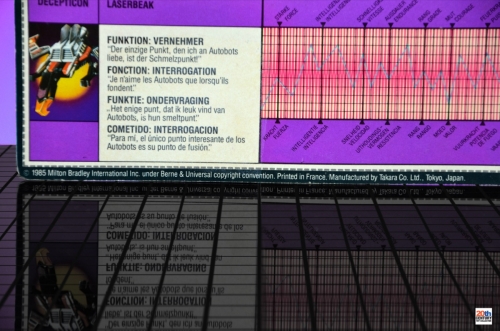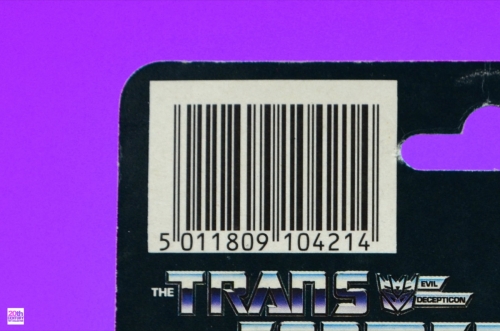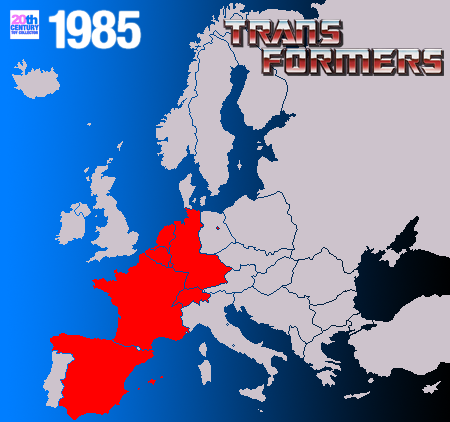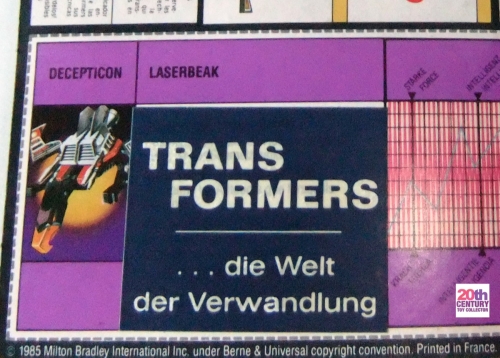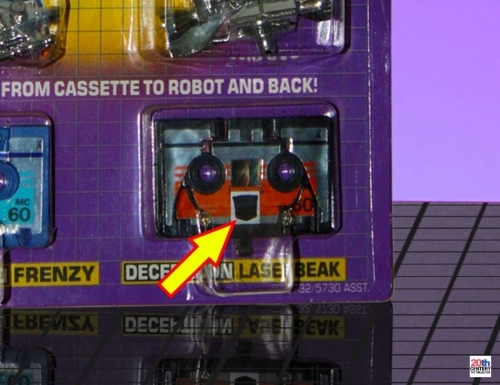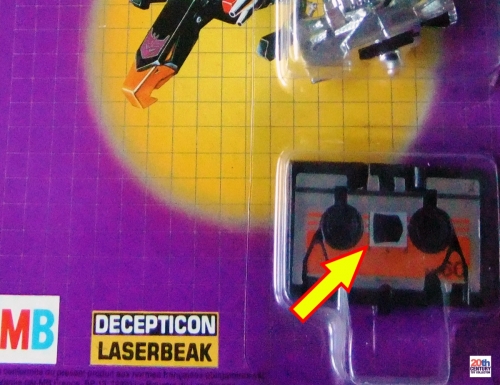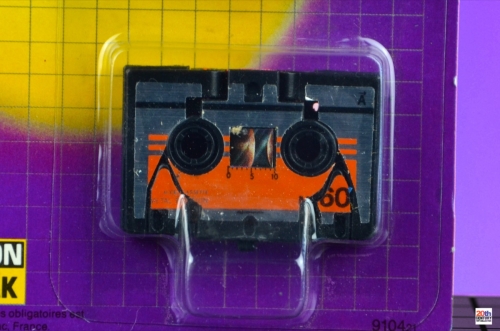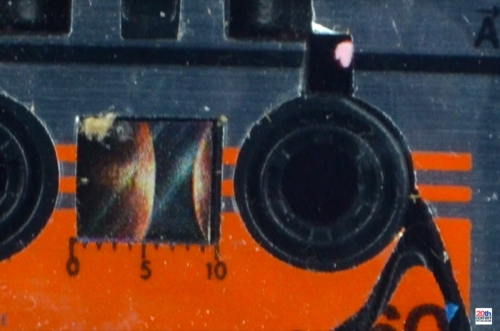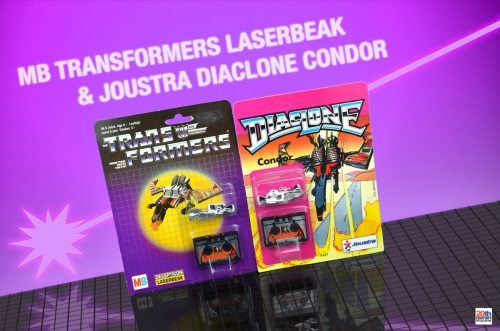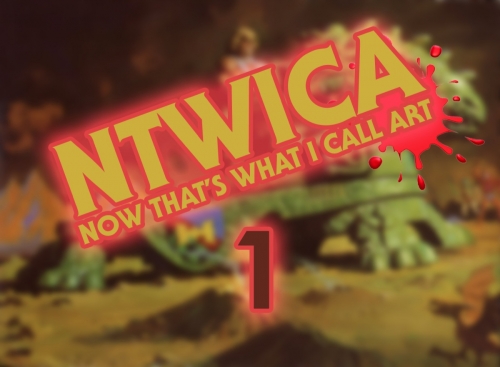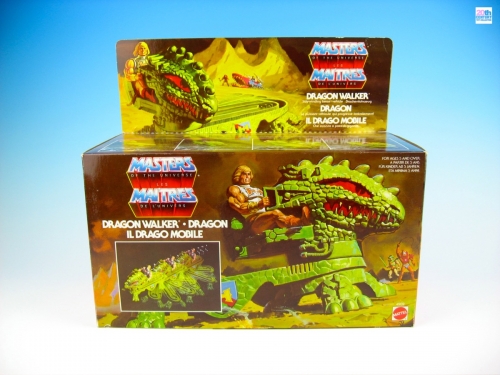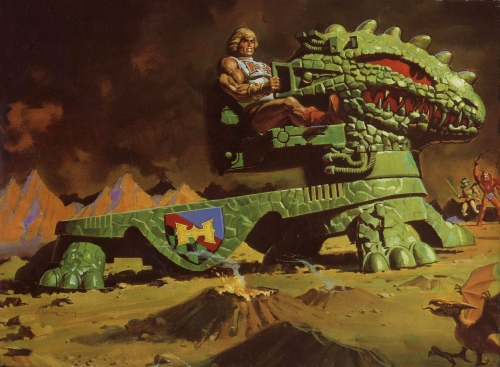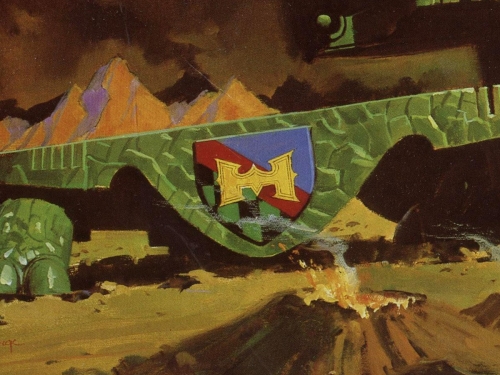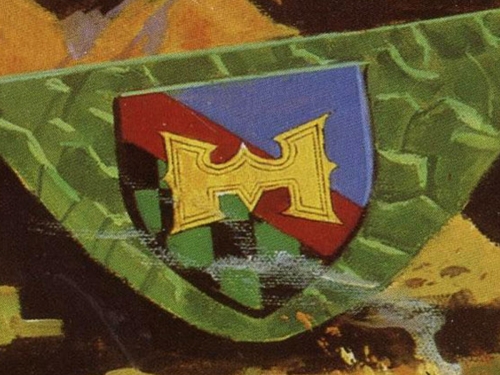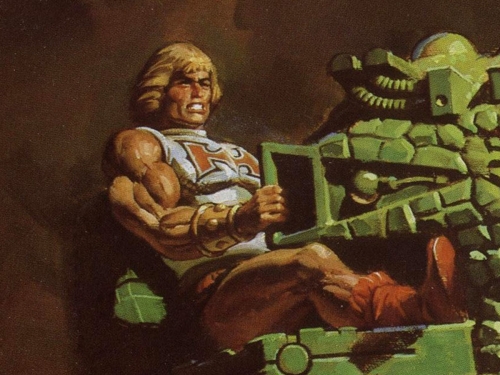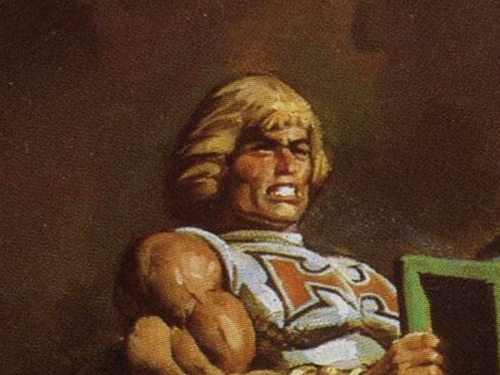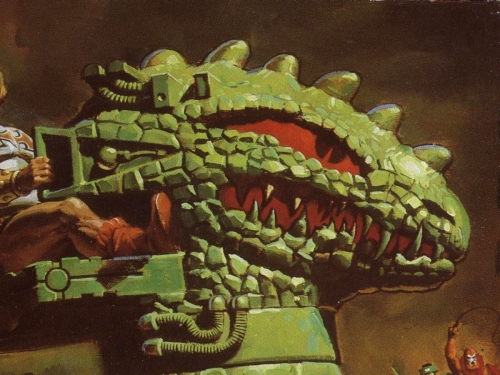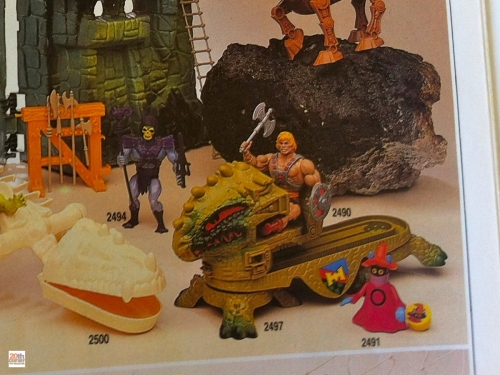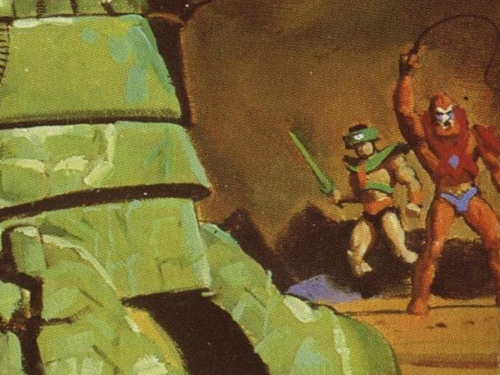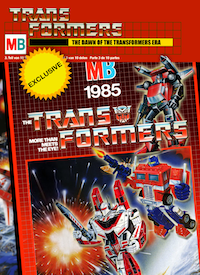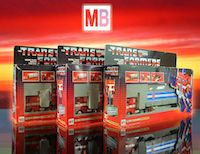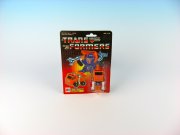Waaaaaaay back in the early mists of time (in the year 2009) I dedicated my first post on this site to one of my favourite items in my G1 Transformers collection: MB’s Laserbeak! Since then lots of new information has been discovered about the early European Transformers releases, which this particular Laserbeak is a part of. Reason enough to warrant a new blog post dedicated to the old bird, I thought. Let’s have a more in-depth look at MB’s Laserbeak!!
Transformers – Laserbeak (MB) 1985 / Europe
“The Laser Beak”
Laserbeak is one of several cassettes that were created for the evil Decepticon Soundwave. The idea was pure Japanese genius. Have a robot transform into a cassette player and then, to top that off, create smaller robots that change into cassettes that fit into the aforementioned cassette player!
Soundwave & Buzzsaw (1985) MB Transformers trade catalog
The name Laserbeak is -of course- a rather clever play on the term “laser beam”. The name was thought up by Marvel Comics writer Bob Budiansky, who was also responsible for writing the cool Transformers bio’s for most of the tech spec cards in the early days and almost every frickin’ other Transformers name there was in the first few years!
The talented Mr. Budiansky
“1985: More Than Meets The Eye!”
Before we continue, I’d like to introduce a little context now. There’s an interesting back story to the introduction of Transformers in continental Europe and this particular Laserbeak release is inextricably part of this story. In short, the story goes like this: Transformers were originally invented by a Japanese toy manufacturer called Takara. And they were not called “Transformers”, but “Diaclone” and “MicroChange”. In 1983 Hasbro bought the rights from Takara to release these toys in its home markets. After a very successful introduction in 1984 in Hasbro’s primary markets (USA, Canada and UK) it was time to introduce the Transformers toy line in Europe. This occurred in the fall of 1985 and in most European countries the introduction of the toy line was handled by Hasbro’s newly acquired subsidiary MB (Milton Bradley), well known manufacturer of puzzles and board games. Due to licensing issues a lot of well known, early Transformers were not available to MB so a limited line up was released at first, which we can retrospectively refer to as “wave 1”. It consisted mostly of 1985 Transformers , which were free of licensing issues. Lots of 1984 Transformers like Optimus Prime, Starscream, most Autobot cars and many more were unavailable to MB. Here’s a list of all the Transformers that MB initially only planned to release (i.e. “wave 1”):
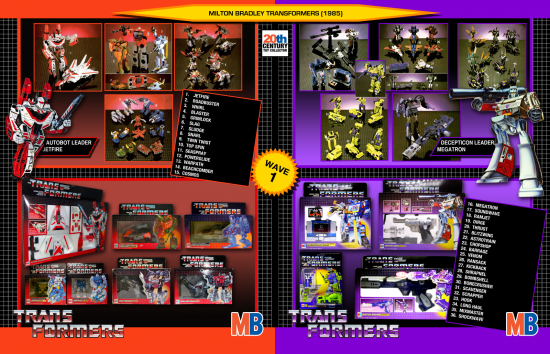
Transformers – wave 1 (MB) 1985
Somewhere during 1985 the aforementioned licensing issues were ironed out and MB obtained the European rights to release these 1984 Transformers after all. Ironically enough these “older” Transformers were released as what we now can refer to as “wave 2”. Laserbeak is part of this second wave as you can see in the list below:
Transformers – wave 2 (MB) 1985
These licensing issues were all due to the fact that a French toy company called Ceji had also negotiated a deal with Takara in 1983 to market these transforming robots in their respective markets, which was a significant chunk of Europe (France, West-Germany, the Benelux and maybe even more countries). Ceji released these transforming robots in 1984 and 1985 under the original Diaclone brand. This is what they released:
Joustra Diaclone pre-Transformers – waves 1 and 2 (1984-1985)
Somewhere during 1985 (but after most of the first promotional material was already printed) MB / Hasbro came to an agreement with Ceji which allowed MB to acquire all of Ceji’s remaining stock of Diaclones and subsequent rights to release them in Europe as Transformers. The Diaclone toys needed to be rebranded as Transformers, which meant they needed to be put inside Transformers packaging, Transformers sticker sheets and instruction booklets were added, rub-signs were placed on the toys and voila! The former Diaclone toys were now Transformers!
From Condor and Jaguar (1984) to Laserbeak and Ravage (1985)
With that little history lesson out of the way, let’s shift our focus back to Laserbeak!
“Artwork”
One of the reasons why I like the MB version of Laserbeak so much (as a collector who likes to collect vintage toys in their original packaging) is that the packaging design is rather unique. Most of the other G1 Transformers that were released in Europe came in packaging that was nearly identical to the original American packaging, but with slight alterations for the European market. Problem is, that for the release of Laserbeak MB did not have a ready-to-go American packaging design to copy and adapt. Why? Well, because in the US all the cassettes were sold as dual-packs and Laserbeak came together with Frenzy.
Transformers – Frenzy & Laserbeak (Hasbro) 1984 / USA
However, MB did not have any Frenzy’s available for release for Europe so copying the American packaging was not an option. The reason why MB did not have any Frenzy’s was of course because Ceji did not have any! So a separate design for the Laserbeak packaging was needed specifically for the MB markets, which ultimately resulted in this über cool piece of 1980’s packaging design:
Transformers – Laserbeak (MB) 1985
How cool is that! I remember very well seeing this card for the first time and totally falling in love with it. The artwork on the card has much more impact now that Laserbeak is pictured solo. The design looks a lot less cluttered. Nice and clean. Here’s a close up of the Laserbeak artwork on the card:
MB Laserbeak artwork
Doesn’t it look amazing? The yellow spotlight behind Laserbeak looks a lot like a hot and scorching alien sun and adds a very dramatic feel to the whole. Also, if you look very closely and compare the artwork on this MB card with that of the American card you can see that the MB Laserbeak artwork has been rotated a couple of degrees counter clockwise, which adds to the impression that this bird of prey is getting ready to dive towards an unsuspecting victim! That.. is.. cool..
“From the Front…”
Let’s have a detailed look at the rest of the front of the packaging. At the top left corner of the card we find the quad-lingual age notice (in German, French, Dutch and Spanish) split over two lines, just like MB’s other wave 2 minibots have (the wave 1 MB minibots have the age notice at the opposite side of the card and on one line instead of two).
MB Laserbeak – quad-lingual age notice
While the American Transformers packaging almost exclusively uses the Eurostile family of typefaces, the texts that are added to the European packaging are exclusively done with the Helvetica family, as are the age notices above.
Moving on to the bottom left of the card we see the MB logo instead of the Hasbro logo. Notice also how the MB logo takes up more space than the Hasbro logo usually does on the American packaging. The Hasbro logo on American packaging usually takes up exactly four grid squares. The MB logo box is slightly larger than that and as such does not align perfectly with the grid on all four sides. Again the wave 1 minibots are different in that respect. While the wave 2 minibots have this oversized MB logo, all the wave 1 minibots have a “normal” sized MB logo, which is exactly four grid squares.
MB Laserbeak – MB logo and compliance statement
Below the logo there’s some text in French. It’s a legal statement saying that compliance of this product with all French laws is guaranteed by MB France S.A., the French Milton Bradley subsidiary. It looks like products sold in France were legally required to have this statement and contact information on the packaging. I have seen examples of MB Transformers packaging where this exact statement is included in the form of a sticker, because the original packaging did not carry the statement. Note also the contrast between the typefaces. Laserbeak’s name badge is printed in Eurostile, while the legal blurb below is printed in Helvetica. MB’s logo by the way is also Helvetica.
“Spy Cassette Assortment”
Moving right along to the opposite side, on the bottom right, we find the SKU (stock keeping unit) code of MB’s Laserbeak, which is 9104 21.
MB Laserbeak – SKU code 9104 21
MB International’s SKU codes in Europe in the 1980’s (and early 90’s) were usually 6 digits long and could be broken down into two segments. The first segment is 4 digits long and is the main identifier. It usually represents a specific item or assortment of items. The second segment is a 2-digit number, which is often printed in a smaller point size than the 4-digit number. This 2-digit suffix represents variations. Sometimes it is used to indicate a specific language version of a product, but in this case it is used to individually refer to a Transformer within an assortment. The number 9104 is given to both of MB’s spy cassettes (Laserbeak and Ravage), which means they were probably sold together as part of an assortment, meaning a retailer could place an order for 9104 and would get a case of 12 or 24 Laserbeaks and Ravages. Within the 9104 assortment, the variation number 20 is assigned to Ravage and the number 21 is assigned to Laserbeak. Here’s a scan from the European 1985 Milton Bradley Transformers trade catalog supplement showing both cassettes with their numbers:
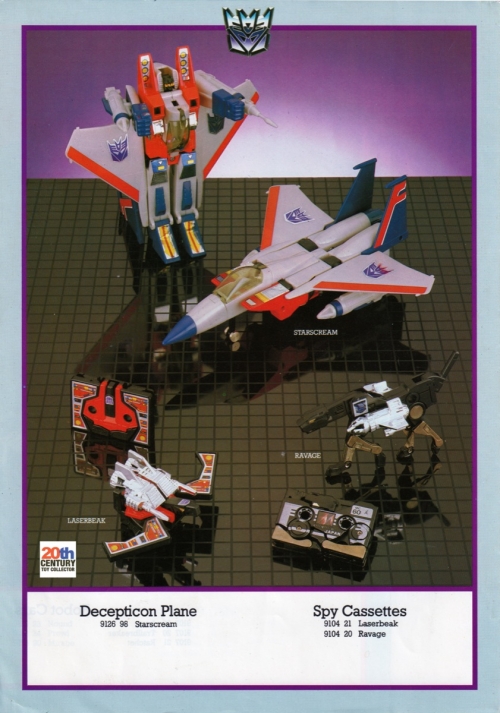
Spy Cassettes – MB Transformers trade catalog supplement (1985)
“…to the Back”
Now let’s turn the card around and see what we can find on the back of the packaging. First, here’s a photo of the back of the card in its entirety.
MB Laserbeak – back of the packaging
Our first point of interest is the tech spec section, which takes up half of the card. The size of the tech spec section is bigger than that on American Transformers packaging, because of the need to display four languages instead of one. Also, this means no room was left for the bio, so only the function and motto remain. Here’s a close up photo of the tech spec section.
MB Laserbeak – motto and tech specs
Laserbeak’s function, motto and tech specs are the same as on the American release, just translated into German, French, Dutch and Spanish. Right below the tech specs is the copyright and manufacturer info. The copyright is attributed to Milton Bradley International, Inc., which used to be the foreign arm (from a US perspective) of the Milton Bradley Company to which all the European Milton Bradley subsidiaries belonged. The copyright conventions being referred to (Berne and UCC) are explained in more detail in an article I wrote here. As for the manufacturer info: the packaging is printed in France and the toy itself was made in Japan by Takara. So why is it that Laserbeak was made in Japan, but the packaging printed in France? Well, because of this particular toy’s history as we examined at the beginning of this article! This Laserbeak was originally manufactured in Japan by Takara and sent to the French toy manufacturer Ceji to sell in France as the Diaclone Condor! When Ceji agreed to sell their remaining stock of Diaclone pre-Transformers (including this Laserbeak) to MB in 1985 for inclusion in their Transformers line the product was already in France, so the Transformers packaging was printed in France!
“Barcode”
Let’s continue our exploration of the back of the packaging. At the top left we find the barcode and underneath that there’s the Transformers logo. Let’s check out the barcode for a moment (yes.. I am going there).
MB Laserbeak – barcode
The barcode shown here is known as an EAN-13 barcode, which back in 1985 used to stand for European Article Number . The “13” refers to the number of digits that make up the barcode. So what’s so interesting about that? Well, those numbers actually mean something and here’s what:
- The first three digits of the bar code are the so called GS1 prefix, which signifies the country where the manufacturer is registered . Laserbeak comes with “501” as GS1 prefix, which is a code that belongs to the UK. This is interesting, because it suggests involvement from a company in the UK in the process of bringing this product to market in continental Europe. It’s pretty much a safe bet that this UK entity will have been Hasbro Europe (or Hasbro UK or whatever it was called in 1985).
- The next three digits are the company number, which is “180”. Hasbro Europe also sometimes used the company number “099”, but most Hasbro toys that were released in continental Europe up to and including 1987 came with a company number of “180”. From 1988 onwards the number “099” seems to have become more dominant.
- Right after the company number the next six digits of the barcode are the item reference. The item reference here is 910421. That sounds familiar! That is exactly the same as MB’s SKU code for Laserbeak: 9104 21! This is actually a very common occurrence, i.e. for manufacturers to encode their SKU numbers into the item reference section of a barcode.
- The last digit of the barcode (“4”) is not interesting to us, because it is simply a checksum digit (a mathematical error detection mechanism).
“Availability”
This particular toy hit the European market in late 1985, which is when the Transformers finally made their entry into most of Europe through Hasbro’s newly acquired subsidiary MB (Milton Bradley, taken over by Hasbro in September, 1984). Laserbeak was probably available in most European markets where MB had local subsidiaries in 1985, which were: France, West-Germany, the Benelux, Spain and Switzerland . These countries are marked in red in the map of Europe below:
Availability of MB Laserbeak in Europe (1985)
It’s hard to say for sure if all these countries got MB Laserbeaks and if so in which quantities (or if any at all!) Exact details on distribution of Transformers in the early days in Europe is hard to find and I’ve learned through research that you shouldn’t assume too much based on just catalogues. Just because these Transformers were depicted in European catalogues did not mean it’s a guarantee that all of them were available in every country.
MB Laserbeaks were definitely available in West-Germany though, as that is where this particular specimen from my collection hails from. It was part of a batch of unsold toy store stock from a German toy store. It also originally had a special sticker that was attached to the back of the card. The sticker contained some German text and covered up the part which shows Laserbeak’s motto in four European languages. Here’s that sticker in question:
MB Laserbeak with German sticker on back of card
This sticker says “TRANSFORMERS …the world of transformation” and was undoubtedly added by the local German MB subsidiary back in 1985, which was ‘Milton Bradley GmbH’ from Soest, West-Germany. I know of one other collector who bought an MB Laserbeak from the same source as I did and that one came with that same German sticker on the back. Why did Milton Bradley GmbH add this sticker to Laserbeak’s packaging? Well, my guess is that they did this to make the product more appealing (or more understandable) to prospective German buyers. This particular portion of the packaging is probably the most conspicuous as far as the negative consequences of having everything printed in four languages is concerned. It might have been that Milton Bradley GmbH decided that four languages of text was too confusing for the consumer, so they decided to cover that up with this sticker containing just German text. When translated into English it sounds a little corny, but in German the text is actually pretty cool if you ask me. This type of customization for the local market is totally in line with everything I have seen so far in my research. Hasbro delivered the product, but the local MB subsidiaries in the various European markets enjoyed a large degree of autonomy in deciding how, when and if the product was marketed and distributed in their home countries.

Laserbeak & Ravage in MB/Hasbro 1986 pack-in catalog (Europe)
I am pretty convinced MB’s Laserbeak was available in France as well by the way, because I have what I believe to be a loose MB Laserbeak and Ravage that I bought from a French seller in 2012. The MB Laserbeak and Ravage can be recognized by their unusual rub-sign placement and that leads us into the next subject matter I would like to discuss….
“Rubbed the wrong way”
On to the matter of the rub-sign and that’s where things start to become a little peculiar. As most vintage G1 Transformers collectors will know, the rub-sign was a nifty little addition that Hasbro introduced in 1985 in an effort to distinguish their “real” Transformers toys from knock offs or (parallel/grey imports of) Diaclones. The rub-sign was a special heat sensitive sticker that would reveal the sign of the faction that the robot belonged to when exposed to heat, which was either the Autobot or Decepticon logo, coincidentally both trademarked by Hasbro. The rub-sign technology itself was also patented by Hasbro. Also, contrary to today, back in 1985 the heat sensitive rub-sign was probably a lot harder (and more expensive) to duplicate by unauthorized parties, even if the trademark and patent rights weren’t enough to scare them off. It was a relatively effective way of letting kids know that only the Hasbro imported Transformers were real Transformers!
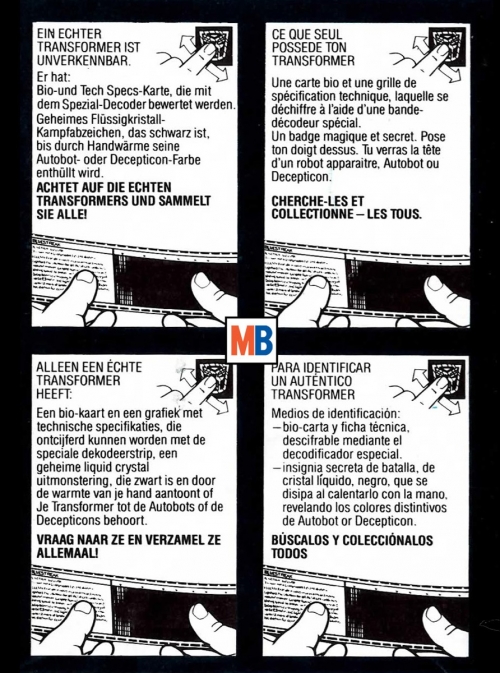
MB rub-sign instructions (German, French, Dutch, Spanish)
And here’s a photo of the back of the MB Laserbeak packaging which shows the rub-sign instructions in four European languages (German, French, Dutch and Spanish).
Rub-sign instructions
So, how do the rub-signs fit into MB’s Transformers line? Well, as far as wave 1 is concerned, these all came with rub-signs applied and are nothing out of the ordinary. And that’s not such a surprise, because all of them were manufactured and packaged in Japan by Takara, just like all the Transformers that were destined for the North American market. However, MB’s wave 2 Transformers are a whole different story altogether. As a general rule, the wave 2 MB Transformers did come with rub-signs, but as is totally consistent with all the weirdness we’ve seen so far with these early European releases, the application of these rub-signs is often different from the standard:
- Rub-signs are placed at different locations than where the American and Japanese releases would have them.
- Rub-signs were placed upside down
- and in some cases there would not be a rub-sign at all!
Case in point being the MB Laserbeak. The normal spot to find the rub-sign on a Laserbeak that was released in the US is on the sticker side, right under the little tape window. Here’s a closeup that shows the rub-sign on an American Laserbeak:
US Laserbeak – “normal” rub-sign placement
On the handful of MB Laserbeaks I have seen so far in unopened packaging Laserbeak has the rub-sign placed right between the two reels, covering up the tape window. The rub-sign is also rotated 90 degrees either clockwise or counter clockwise (both variations exist!!!). Here’s an example of a mint-on-sealed-card MB Laserbeak with a rub-sign rotated 90 degrees counter clockwise:
MB Laserbeak – unusual rub-sign placement
So where does my MB Laserbeak have its rub-sign? The answer to that is… nowhere! My particular MB Laserbeak, which probably came from the very same factory case as the one with the rub-sign above, does not seem to have a rub-sign at all. Check it out:
MB Laserbeak – no rub-sign
This is really funny if you think about it. Here we have MB and Hasbro hammering home the difference between official Transformers and unofficial Transformers (“Hey kids, real Transformers have rub-signs!”) and on the back of the packaging of MB’s Laserbeak there are rub-sign instructions, but the actual toy inside the packaging does not have a rub-sign at all! I wonder if any kids returned their MB Transformers to the store back in 1985 claiming they were fakes, because they did not have a rub-sign! LOL!
There is of course a slight chance that the rub-sign is located at the other side of the cassette on my MB Laserbeak, which is not visible the way it is packaged, but given the rub-sign inconsistencies seen so far and the fact that it’s hard to find a good spot for a rub-sign on the other side of the Laserbeak cassette I am more inclined to believe that this one has no rub-sign at all. There is one way to find out for sure, but I was not planning on opening this sealed specimen any time soon ;-)
There’s one more detail I noticed on my MB Laserbeak when I was studying it closely under a magnifying glass (I know, I know…. geek city) and that is that there are several imperfections on the sticker, the most noticeable of all being the tear at the top left of the tape window and some dust and dirt here and there. Here’s a close up photo:
MB Laserbeak – sticker damage
These imperfections puzzled me at first. It looked like a slightly used Laserbeak, but it was sealed tightly shut, so it couldn’t be! However, placed against the background of this toy’s history these imperfections start to make sense. There’s a lot of evidence that suggests that the French company Ceji did not only sell their stock of Diaclones to MB in 1985, but that they also took care of the rebranding process as well (the repackaging of their Diaclone stock into MB Transformers packaging). It seems there was a lot of manual labour involved there and the inconsistent rub-sign placements (or lack thereof) seem to be a testament to this. These MB Laserbeaks did not come straight off Takara’s production lines. They were sent to France and some of them may have even ended up in Ceji Joustra’s Diaclone packaging before being reallocated to MB’s Transformers line. Who knows how the actual rebranding process worked and how the product was handled during this process.
“Two Birds, One Stone”
I hope you enjoyed reading this detailed look at MB’s Laserbeak. Like most other wave 2 MB Transformers it has a special history that is closely tied to that of Ceji’s Joustra Diaclone line, which only adds to its appeal in my opinion.
MB Laserbeak (1985) and Ceji Joustra Condor (1984)
I am desperately on the look out for the MB Ravage to place alongside my MB Laserbeak, but that item has proven to be the most difficult one to track down yet in its original packaging. If you ever find one or have one for sale I will gladly take it off your hands for a handsome sum ;-) Thanks for reading and see you back soon!
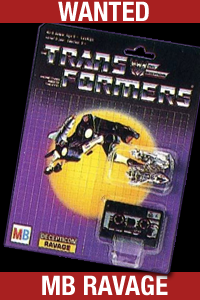
“Notes, References and Acknowledgments”









